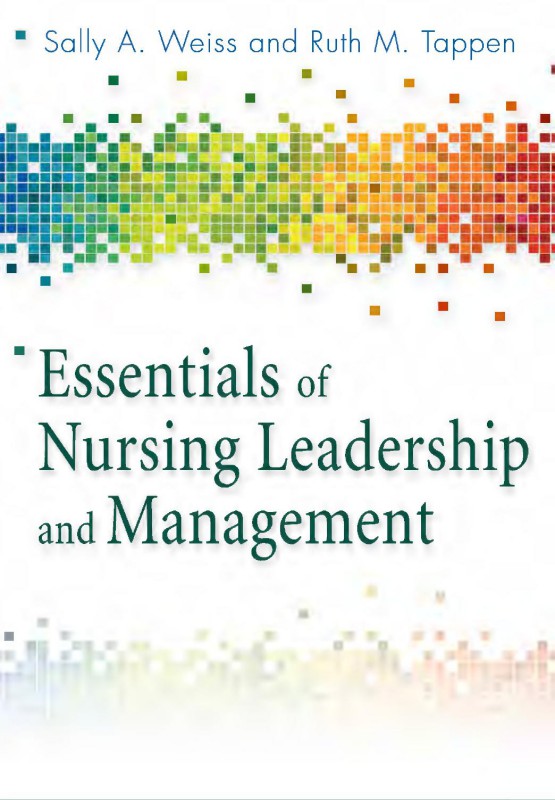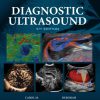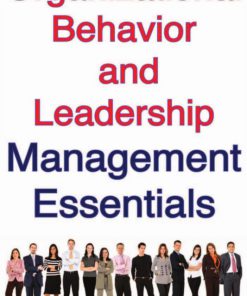Essentials of Nursing Leadership And Management 6th Edition by Sally Weiss, Ruth Tappen 0803636636 9780803636637
$50.00 Original price was: $50.00.$25.00Current price is: $25.00.
Authors:Weiss, Sally,Tappen, Ruth , Author sort:Weiss, Sally,Tappen, Ruth , Published:Published:Sep 2014
Essentials of Nursing Leadership And Management 6th Edition by Sally Weiss, Ruth Tappen – Ebook PDF Instant Download/Delivery. 0803636636, 9780803636637
Full download Essentials of Nursing Leadership And Management 6th Edition after payment

Product details:
ISBN 10: 0803636636
ISBN 13: 9780803636637
Author: Sally A Weiss; Ruth M Tappen
Successfully make the transition to professional nursing practice. Two books in one, for the price of one―all the issues and trends coverage you need, plus leadership and management content. The completely revised and updated 6th Edition of this popular resource prepares you to meet the challenges you’ll face as a professional in today’s changing health care environment. You’ll explore your future responsibilities as a leader and a manager and the workplace issues and trends that you’ll encounter in practice. A wealth of resources online at DavisPlus provides tools to hone your skills and prepare for the future, including interactive case studies, review questions, bonus chapters, a resume template, sample letters and emails, and much more.
Essentials of Nursing Leadership And Management 6th Table of contents:
unit 1 Professional Considerations
chapter 1 Leadership and Followership
OBJECTIVES
Leadership
Are You Ready to Be a Leader?
Leadership Defined
What Makes a Person a Leader?
Leadership Theories
Trait Theories
Behavioral Theories
table 1-1 Comparison of Autocratic, Democratic, and Laissez-Faire Leadership Styles
Task Versus Relationship
Motivation Theories
Emotional Intelligence
table 1-2 Leading Motivation Theories
Situational Theories
Transformational Leadership
box 1-1 BHAGs, Anyone?
Moral Leadership
Caring Leadership
box 1-2 Distinctive Styles of Leadership
Qualities of an Effective Leader
Figure 1.1 Keys to effective leadership.
table 1-3 Winner or Whiner—Which Are You?
Behaviors of an Effective Leader
Followership
Followership Defined
Becoming a Better Follower
Managing Up
Conclusion
Study Questions
Case Study to Promote Critical Reasoning
References
chapter 2 Manager
OBJECTIVES
Management
Are You Ready to Be a Manager?
What Is Management?
Management Theories
Scientific Management
table 2-1 Differences Between Leadership and Management
Human Relations–Based Management
Servant Leadership
Figure 2.1 Theory X versus Theory Y.
Qualities of an Effective Manager
Behaviors of an Effective Manager
Interpersonal Activities
Figure 2.2 Keys to effective management.
Decisional Activities
Informational Activities
table 2-2 Bad Management Styles
Conclusion
Study Questions
Case Studies to Promote Critical Reasoning
Case I
Case II
References
chapter 3 Nursing Practice and the Law
OBJECTIVES
General Principles
Meaning of Law
Sources of Law
The Constitution
Statutes
Administrative Law
Types of Laws
Criminal Law
Civil Law
Tort
Quasi-Intentional Tort
Negligence
Malpractice
Other Laws Relevant to Nursing Practice
Good Samaritan Laws
Confidentiality
Social Networking
Slander and Libel
False Imprisonment
Assault and Battery
Standards of Practice
Use of Standards in Nursing Negligence Malpractice Actions
Patient’s Bill of Rights
Informed Consent
Staying Out of Court
Prevention
box 3-1 Tips for Avoiding Legal Problems
table 3-1 Common Causes of Negligence
Appropriate Documentation
box 3-2 Some Documentation Guidelines
Medications
Physician Communication
Formal Issues in Charting
Common Actions Leading to Malpractice Suits
If a Problem Arises
Professional Liability Insurance
End-of-Life Decisions and the Law
Do Not Resuscitate Orders
box 3-3 Elements to Include in a DNR Order
Advance Directives
Living Will and Durable Power of Attorney for Health Care (Health-Care Surrogate)
Nursing Implications
Legal Implications of Mandatory Overtime
Licensure
Qualifications for Licensure
Licensure by Examination
NCLEX-RN
table 3-2 Major Categories and Subcategories of Client Needs
Preparing for the NCLEX-RN
Licensure Through Endorsement
Multistate Licensure
Disciplinary Action
Conclusion
Study Questions
Case Study to Promote Critical Reasoning
Case Study on Mandatory Overtime
References
chapter 4 Questions of Values and Ethics
OBJECTIVES
Values
Morals
Values and Moral Reasoning
Value Systems
How Values Are Developed
Values Clarification
box 4-1 Values Clarification
Choosing
Prizing
Acting
Belief Systems
Ethics and Morals
Ethics
Ethical Theories
Ethical Principles
Autonomy
Nonmaleficence
Beneficence
Justice
Fidelity
Confidentiality
Veracity
Accountability
Ethical Codes
Virtue Ethics
Nursing Ethics
Organizational Ethics
Ethical Issues on the Nursing Unit
Moral Distress in Nursing Practice
Ethical Dilemmas
Resolving Ethical Dilemmas Faced by Nurses
Assessment
box 4-2 Questions to Help Resolve Ethical Dilemmas
Planning
Implementation
Evaluation
box 4-3 The Moral Model
Current Ethical Issues
Practice Issues Related to Technology
Genetics and the Limitations of Technology
Stem Cell Use and Research
Professional Dilemmas
Conclusion
Study Questions
Case Study to Promote Critical Reasoning
References
unit 2 Working Within an Organization
chapter 5 Organizations, Power, and Empowerment
OBJECTIVES
Understanding Organizations
Types of Health-Care Organizations
Scenario 1
Scenario 2
Organizational Characteristics
Organizational Culture
Culture of Safety
Care Environments
Identifying an Organization’s Culture
Organizational Goals
box 5-1 What Is a Bureaucracy?
Structure
The Traditional Approach
Figure 5.1 The organizational ladder.
More Innovative Structures
Processes
Figure 5.2 Table of organization of an ambulatory care center.
Figure 5.3 An organic organizational structure for a nontraditional wellness center.
Power
Definition
Sources
Power at Lower Levels of the Hierarchy
Empowering Nurses
Participation in Decision Making
Shared Governance
Professional Organizations
Collective Bargaining
Enhancing Expertise
Figure 5.4 How to increase your expert power.
Conclusion
Study Questions
Case Study to Promote Critical Reasoning
References
chapter 6 Communicating With Others and Working With the Interprofessional Team
OBJECTIVES
Communication
Assertiveness in Communication
Interpersonal Communication
Barriers to Communication Among Health-Care Providers and Health-Care Recipients
Low Health Literacy
Cultural Diversity
Cultural Competence
Interprofessional Communication Education of Health-Care Providers
Electronic Forms of Communication
Information Systems and E-Mail
Electronic Medical Records and Electronic Health Records
table 6-1 Barriers to Effective Communication in Health Care
box 6-1 Potential Benefits of Computer-Based Patient Information Systems
Text Messaging
box 6-2 Rules of Netiquette
Reporting Patient Information
box 6-3 Information for Change-of-Shift Report (Hand-Off)
Hand-Off Communications
Communicating With the Health-Care Provider
ISBARR
Figure 6.1 Organization and time management schedule for patient care.
Figure 6.2 Patient information report.
Health-Care Provider Orders
table 6-2 ISBARR (Introduction, Situation, Background, Assessment, Recommendation, Read-Back)
Teams
Learning to Be a Team Player
Building a Working Team
box 6-4 Ten Qualities of an Effective Team Player
Interprofessional Collaboration and the Interprofessional Team
Interprofessional Collaboration
Interprofessional Communication
Building an Interprofessional Team
box 6-5 Characteristics of Effective Interprofessional Health-care Teams
Conclusion
Study Questions
Case Study to Promote Critical Reasoning
References
chapter 7 Delegation and Prioritization of Client Care
OBJECTIVES
Introduction to Delegation
Definition of Delegation
Assignments and Delegation
box 7-1 The Five Rights of Delegation
Supervision
The Nursing Process and Delegation
The Need for Delegation
Safe Delegation
box 7-2 Seven Components of the Delegation Decision-Making Grid
box 7-3 Five Factors for Determining If Client Care Activity Should Be Delegated
Figure 7.1 Delegation decision-making grid.
Criteria for Delegation
Figure 7.2 Diagram of delegation decision-making grid.
Task-Related Concerns
Abilities
Priorities
Efficiency
Appropriateness
Relationship-Oriented Concerns
Fairness
Learning Opportunities
Health
Compatibility
Staff Preferences
box 7-4 Basic Entitlements of Nurses in the Workplace
Barriers to Delegation
Experience Issues
Licensure Issues
table 7-1 Direct and Indirect Client Care Activities
Legal Issues and Delegation
Quality-of-Care Issues
Assigning Work to Others
Prioritization
Coordinating Assignments
Models of Care Delivery
Functional Nursing
Figure 7.3 Personalized patient worksheet.
Team Nursing
Total Patient Care
Primary Nursing
Conclusion
Study Questions
Case Study to Promote Critical Reasoning
References
chapter 8 Dealing With Problems and Conflicts
OBJECTIVES
Conflict
Many Sources of Conflict
Case 1
Team A and Team B
Power Plays and Competition between Groups
Increased Workload
Multiple Role Demands
Threats to Safety and Security
Scarce Resources
Cultural Differences
Ethical Conflicts
Invasion of Personal Space
When Conflict Occurs
Resolving Problems and Conflicts
Win, Lose, or Draw?
box 8-1 Signs That Conflict Resolution Is Needed
Other Conflict Resolution Myths
Problem Resolution
Identify the Problem or Issue
Generate Possible Solutions
Figure 8.1 The process of resolving a problem.
Review Suggested Solutions and Choose the Best Solution
Implement the Solution Chosen
Case 2
The Vacation
Evaluate: Is the Problem Resolved?
Negotiating an Agreement Informally
Scope the Situation
box 8-2 The Informal Negotiation Process
Set the Stage
Conduct the Negotiation
box 8-3 Tips for Leading the Discussion
Agree on a Resolution of the Conflict
Formal Negotiation: Collective Bargaining
The Pros and Cons of Collective Bargaining
Case 3
Collective Bargaining
Conclusion
Study Questions
Case Study to Promote Critical Reasoning
References
chapter 9 People and the Process of Change
OBJECTIVES
Change
A Natural Phenomenon
Macro and Micro Change
Figure 9.1 The change process.
Change and the Comfort Zone
Resistance to Change
Receptivity to Change
Preference for Certainty
Speaking to People’s Feelings
Sources of Resistance
Technical Concerns
Personal Needs
Figure 9.2 Maslow’s hierarchy of needs.
Position and Power
Recognizing Resistance
Lowering Resistance
table 9-1 Resistance to Change
Sharing Information
Disconfirming Currently Held Beliefs
Providing Psychological Safety
Dictating Change
Leading Change
Designing the Change
Figure 9.3 Four phases of planned change.
Planning
Implementing the Change
Integrating the Change
Personal Change
table 9-2 Which Stage of Change Are You In?
Conclusion
table 9-3 Five Myths About Changing Behavior: An Alternative Perspective
Study Questions
Case Study to Promote Critical Reasoning
References
unit 3 Career Considerations
chapter 10 Issues of Quality and Safety
OBJECTIVES
Overview
Historical Trends and Issues
table 10-1 Historical Timeline
box 10-1 Institute of Medicine Priority Areas (IOM, 2003b)
The Institute of Medicine and the Committee on the Quality of Health Care in America
box 10-2 IOM Quality Reports (IOM, 2006)
box 10-3 Focus Areas of To Err is Human Recommendations (IOM, 2000)
box 10-4 Ten Rules to Govern Health-Care Reform for the 21st Century (IOM, 2001, p. 61)
Quality in the Health-Care System
Quality Improvement (QI)
box 10-5 Six Aims for Improving Quality in Health Care (IOM, 2001, p. 39).
Using CQI to Monitor and Evaluate Quality of Care
QI at the Organizational and Unit Levels
Strategic Planning
Figure 10.1 Unit level QI process.
Structured Care Methodologies
box 10-6 Questions the Team Needs to Ask
Critical Pathways
Aspects of Health Care to Evaluate
Structure
table 10-2 Sample Critical Pathway: Heart Failure, Hospital; ELOS 4 Days Cardiology or Medical Unit
table 10-3 Dimensions of QI in Nursing: Examples
Process
Outcome
Risk Management
The Nursing Shortage and Patient Safety
Factors Contributing to the Nursing Shortage
Safety in the U.S. Health-Care System
Types of Errors
box 10-7 Types of Errors (IOM, 2000, p. 36)
Diagnostic
Treatment
Preventive
Other
Error Identification and Reporting
Developing a Culture of Safety
box 10-8 Joint Commission International Center for Patient Safety
Organizations, Agencies, and Initiatives Supporting Quality and Safety in the Health-Care System
Government Agencies
box 10-9 Organizations and Agencies Supporting Quality and Safety
Government Agencies
Health-Care Provider Professional Organizations
Nonprofit Organizations, Foundations, and Research
Quality Organizations
Health-Care Provider Professional Organizations
Nonprofit Organizations and Foundations
Quality Organizations
Integrating Initiatives and Evidenced-Based Practices Into Patient Care
box 10-10 Core Competencies for Health Professionals (IOM, 2003a, p. 4)
Influence of Nursing
Conclusion
Study Questions
Case Study to Promote Critical Reasoning
References
chapter 11 Promoting a Healthy Work Environment
OBJECTIVES
Workplace Safety
Threats to Safety
Addressing Threats to Safety
OSHA
Centers for Disease Control and Prevention (CDC)
American Nurses Association (ANA)
The Joint Commission
Institute of Medicine (IOM)
Developing Workplace Safety Programs
box 11-1 Federal Laws Enacted to Protect the Worker in the Workplace
Violence
box 11-2 Behaviors Indicating a Potential for Violence
Preventing Violent Behavior
box 11-3 When an Assault Occurs: Placing Blame on Victims
If Violent Behavior Occurs
box 11-4 Steps Toward Increasing Protection From Workplace Violence
Horizontal Violence
Sexual Harassment
box 11-5 Behaviors That Could Be Defined as Sexual Harassment
Discrimination
Latex Allergy
Needlestick (Sharps) Injuries
Your Employer’s Responsibility
Employee Responsibilities
Ergonomic Injuries
Back Injuries
Repetitive Stress Injuries
Toxic Environments
Impaired Workers
Disabled Employees
Natural Disasters and Terrorism Threats
Enhancing the Quality of Work Life
Shift Work Disorders
Mandatory Overtime
Staffing Ratios
Reporting Questionable Practices
Social Environment
Working Relationships
Involvement in Decision Making
Professional Growth and Innovation
Encourage New Ideas and Critical Thinking
Reward Professional Growth
Cultural Diversity
Physical Environment
Stress, Burnout, and Job Satisfaction
Stress
Sources of Stress
Why Is Health Care a Stressful Occupation?
Responses to Stress
Managing Stress
box 11-6 Signs That Your Stress Level Is Too High
box 11-7 Questions for Self-Assessment
Burnout
Stages of Burnout
box 11-8 Useful Relaxation Techniques
box 11-9 Coping With Daily Work Stress
box 11-10 Ten Daily De-Stressors
Buffers Against Burnout
box 11-11 Assessing Your Risk for Stress and Burnout
Job Satisfaction
The Work Itself
The Health-Care Team
The Employing Organization
New Graduates’ Concerns
Initial Concerns
Differences in Expectations
Additional Pressures on the New Graduate
Easing the Transition
table 11-1 Mentor and Mentee Responsibilities
Ineffective Coping Strategies
Conclusion
Study Questions
Case Studies to Promote Critical Reasoning
Diversity
Burnout
References
unit 4 Professional Issues
chapter 12 Your Nursing Career
OBJECTIVES
Getting Started
SWOT Analysis
Strengths
Weaknesses
Opportunities
Threats
Beginning the Search
Researching Your Potential Employer
Writing a Résumé
box 12-1 Reasons for Preparing a Résumé
Essentials of a Résumé
table 12-1 Action Verbs
How to Begin
Education
Your Objective
Skills and Experience
Other
Job Search Letters
Cover Letter
Thank-You Letter
Acceptance Letter
Rejection Letter
table 12-2 Do’s and Don’ts of Internet Job Searching
Using the Internet
The Interview Process
Initial Interview
Answering Questions
Background Questions
Professional Questions
Personal Questions
Additional Points About the Interview
Appearance
Handshake
Eye Contact
Posture and Listening Skills
Asking Questions
box 12-2 Do’s and Don’ts for Interviewing
Do:
Do Not:
After the Interview
The Second Interview
Making the Right Choice
Job Content
Development
Direction
Work Climate
Compensation
I Cannot Find a Job (or I Moved)
The Critical First Year
Attitude and Expectations
Impressions and Relationships
Organizational Savvy
Skills and Knowledge
Advancing Your Career
Conclusion
Study Questions
Case Study to Promote Critical Reasoning
References
chapter 13 Evolution of Nursing as a Profession
OBJECTIVES
Introduction
Nursing Defined
Early and Modern Nurse Leaders
The 19th and 20th Centuries
Nurse Leaders in the 21st Century
Linda Aiken
Dr. Beverly Malone
Dr. Tim Porter-O’Grady
Political Influences and the Advance of Nursing as a Profession
Nursing and Health Care Reform
Nursing Today
Health Care in the Future
Conclusion
Study Questions
Case Study #1 to Promote Critical Reasoning
Case Study #2 to Promote Critical Reasoning
References
chapter 14 Looking to the Future
OBJECTIVES
Professional Organizations
American Nurses Association (ANA)
National League for Nursing
box 14-1 American Nurses Association (ANA) Position Statements
Bloodborne and Airborne Diseases
Consumer Advocacy
Drug and Alcohol Abuse
Environmental Health
Ethics and Human Rights
Nursing Practice
Social Causes and Health Care
Unlicensed Personnel
Workplace Advocacy
box 14-2 Canadian Nurses Association (CNA) Position Statements
Nurse Practitioners and Clinical Nurse Specialists
RN Licensing
Nursing Ethics
Leadership
Fixing the Health Care System
Primary Health Care
Nursing and Environmental Health
Public Health
Mental Health
Emergency Preparedness
Improve Your Workplace
Staffing
Patient Safety
Nursing Informatics
Global Health Issues
National Organization for Associate Degree Nursing
National Student Nurses Association
American Academy of Nursing
National Institute for Nursing Research
Specialty Organizations
Health Care Today
Health-Care Reform
table 14-1 Provisions of the Affordable Care Act 2010–2015
Nursing Today
Trends in Nursing and Health Care
Health Care in the Future
Nursing in the Future
Conclusion
Study Questions
Case Study to Promote Critical Reasoning
References
Back Matter
Appendices
appendix 1 Codes of Ethics for Nurses
American Nurses Association Code of Ethics for Nurses
Canadian Nurse Association Code of Ethics for Registered Nurses
The International Council of Nurses Code of Ethics for Nurses
Nurses and People
Nurses and Practice
Nurses and the Profession
Nurses and Co-Workers
appendix 2 Standards Published by the American Nurses Association*
appendix 3 Guidelines for the Registered Nurse in Giving, Accepting, or Rejecting a Work Assignment*
Nursing Care Delivery
Assignment Despite Objection (ADO)/Documentation of Practice Situation (DOPS)
Staffing
Nurse Practice Act, 1994, Administrative Rules Chapt. 59s, 14.001 Definitions (4/29/96)
Scenario
Guidelines for Decision Making
Legal Issues
Application of Guidelines for Decision Making
Scenario—A Question of Competence
Scenario—A Question of an Additional Shift
Summary
Resources
People also search for Essentials of Nursing Leadership And Management 6th:
9 essential qualities of nurse leadership
essentials of nursing leadership and management quizlet
essentials of nursing leadership and management weiss
essentials of nursing leadership and management case study answers
You may also like…
eBook PDF
Effective leadership management in nursing 8th edition by Eleanor Sullivan 0132814544 978-0132814546












